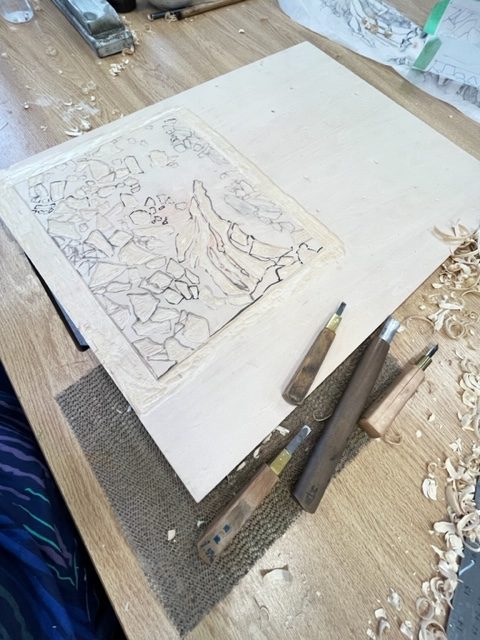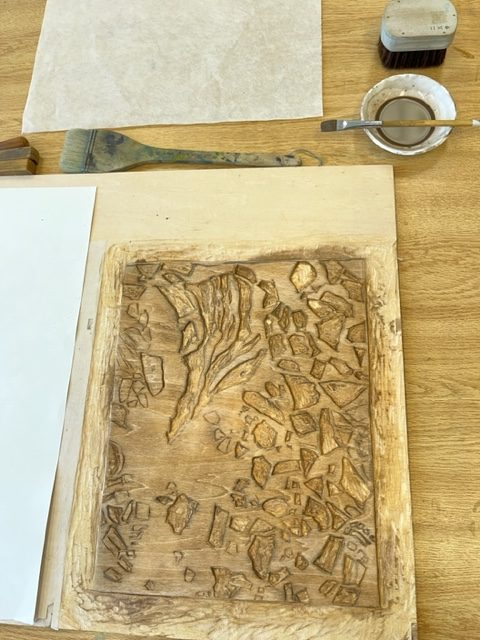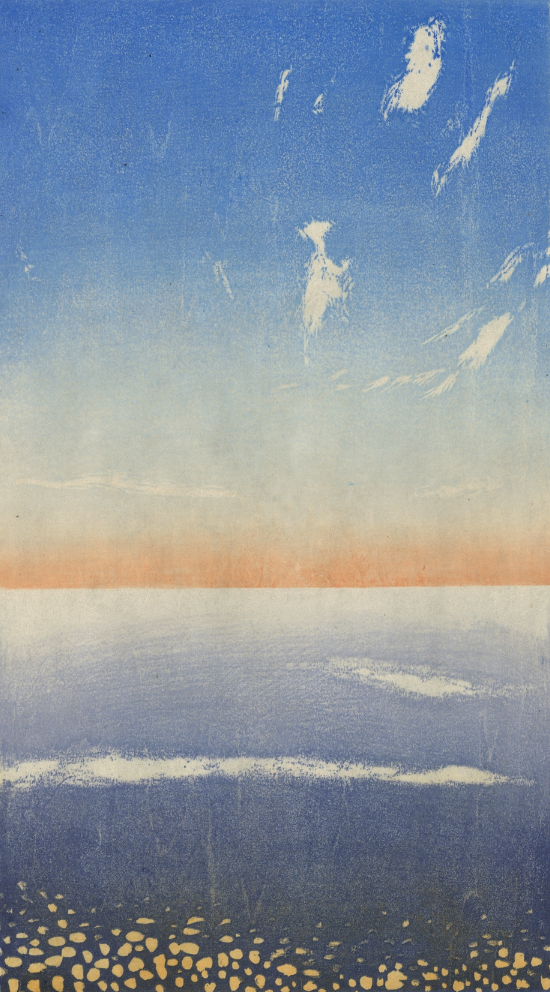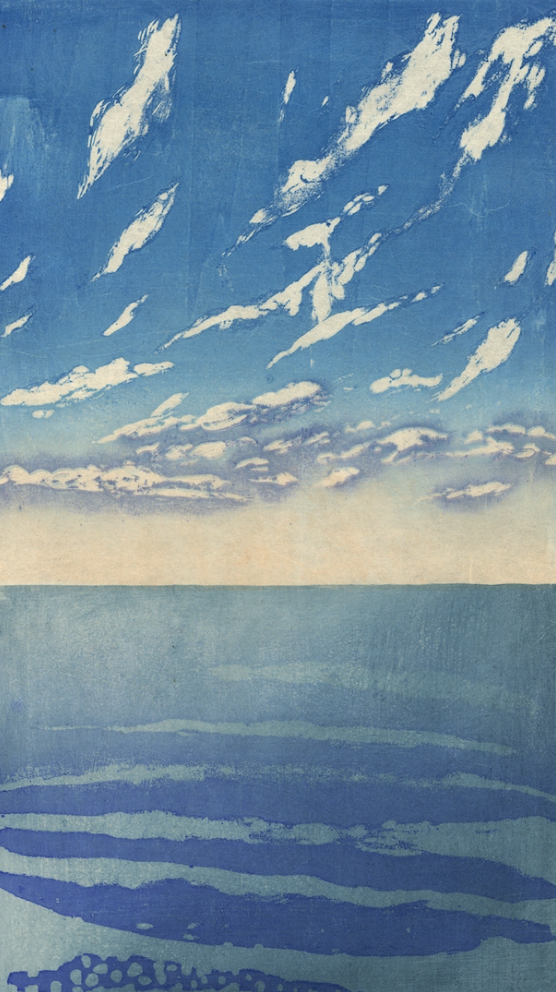In this series, we get to know the Artists behind the work with ten questions about their practice, their space, and their ideas. These are their Stories.
Elizabeth Forrest
Elizabeth Forrest, a printmaking graduate from the Ontario College of Art and Design, broadened her artistic skills in Kyoto, Japan, where she mastered traditional Japanese woodblock printing (“mokuhanga”) in the 90s. Combining mokuhanga with silk screen and pochoir/stencilling, she cultivated a unique mixed-media approach. Elizabeth’s work is characterized by themes ranging from social behaviors to cultural and natural phenomena, often observed through a serial exploration of image approaches. Relocating to Waterloo in 2018, she engaged with the local art scene and secured a public art installation design for two parks, expected to be completed by July 2023. Her consistent use of Japanese paper (“washi”) serves as a foundational element in her primarily paper-based work, framed in a way that highlights the medium’s intrinsic qualities. Her art has been showcased internationally, demonstrating her extensive exhibition history.
What initially inspired you to pursue a career as an artist?
My high school Art teacher took us on a field trip to see a major Picasso exhibition at the AGO in Toronto and I saw Picasso’s etchings for the first time. I was fascinated with the way the glossy lines of ink “sat” on the paper, shaping the image with lines and hatching. That stayed with me: I was drawn to printmaking from that point on. That high school teacher, his enthusiasm and my love of art history led me to want to study art. However, my parents guided me towards getting a proper degree, so it wasn’t until I earned a BA and B.Ed, then taught for 2 years, that I was able to put myself through the Ontario College of Art while working part time. By then, at age 25, I knew for sure this was what I wanted.
Can you describe your artistic style and how it has evolved over time
My subject matter and stylistic approach, although almost always in printmaking, have changed over 30 years of professional output and I have worked in both representational and abstract imagery. Japanese woodblock (mokuhanga) with the watercolour medium of gouache has been my choice of medium for many years. While the subject changes, the medium itself creates a signature look of transparent, muted matt colour on washi.

Later I began to create representational images in woodblock print at residencies on Toronto Island and as a result of visiting Newfoundland.
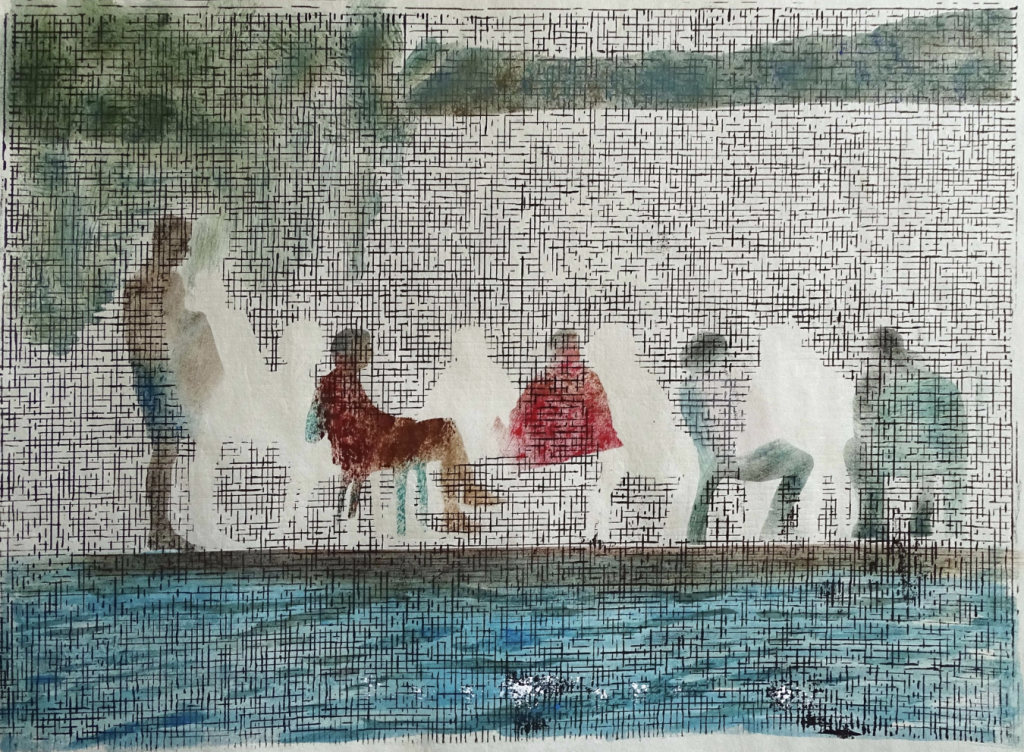
I had learned much about mokuhanga while printing the grid series and applied that to the landscape – related imagery up until 2016. When moving to Waterloo in 2018 I gathered a lot of print proofs and cast offs to recycle into collage work and exhibited this under the title “Revisions”. The work of the last three years, related to the pandemic, turned to figurative themes creating mixed media monoprints using stencil with mokuhanga.
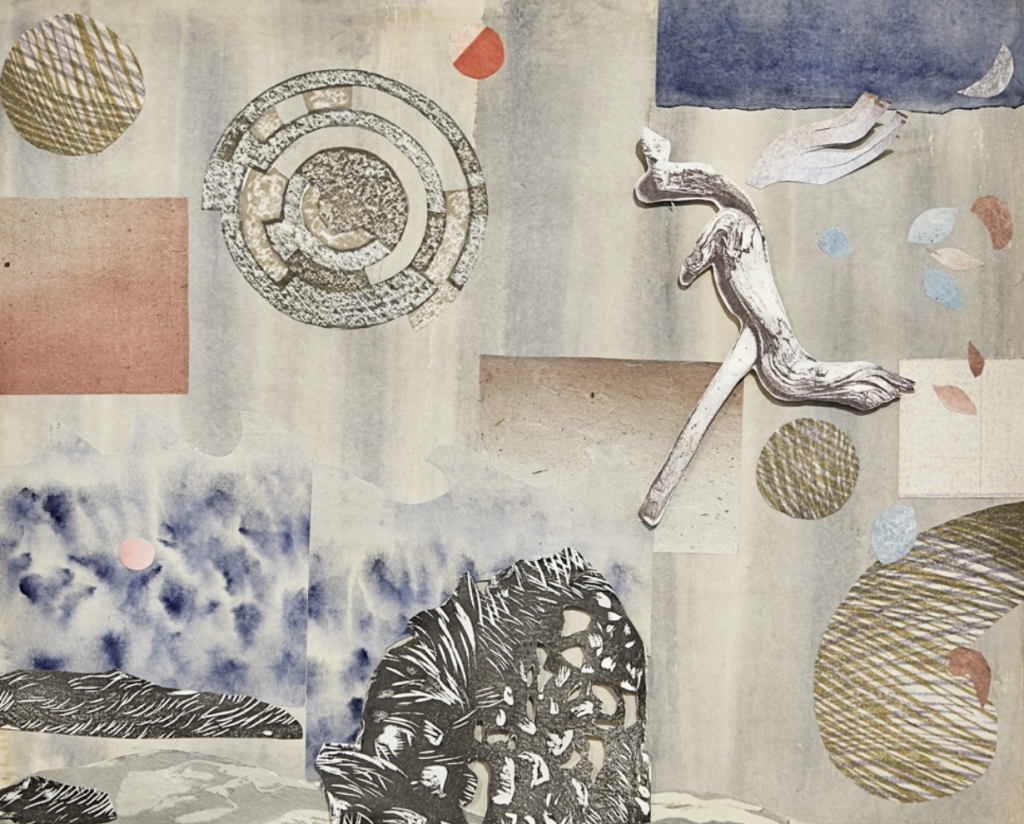
What mediums and techniques do you prefer to work with, and why?
Gouache and washi paper are the two fundemental media I work with. In the early days of my printmaking career I used oil based inks in lithography, screen and relief prints impressed on cotton rag papers. But the strength and absorbancy of Japanese papers (washi) was great to work with,and when I went to Japan to study mokuhanga, my appreciation of the potential of washi increased. Good quality washi is essential to the success of the waterbased print. In graphic art negative space is important so again the quality of the paper becomes important. A handmade washi seems to emit an internal glow.
Gouache pigment used with mokuhanga and monoprints, produces a semi opaque quality of colour that also is absorbed into the paper. A unique beauty and subtle contrast of different qualities of light at the surface of the print emerges, that is not perceptible in any digital image.
How does your background or personal experiences influence your art?
The aforementioned art teacher respected and encouraged originality and I’ve continued to have a critical eye towards my own and others’ work, with “originality” as an important criteria.
My life has had ups and downs like most of us. I lost an important college teaching job but this setback helped me decide to go to Japan and escape the wreckage my life seemed to be. This decision set me on a different trajectory vis a vis the type of work I was doing. No longer did I try to produce large installations but rather created thematically related, and smaller individual prints. With this I left behind the struggle for Canada Council recognition in the form of arts grants and became more professionally minded. That said I did earn some CC grants subsequently. I learned to be just who I am.
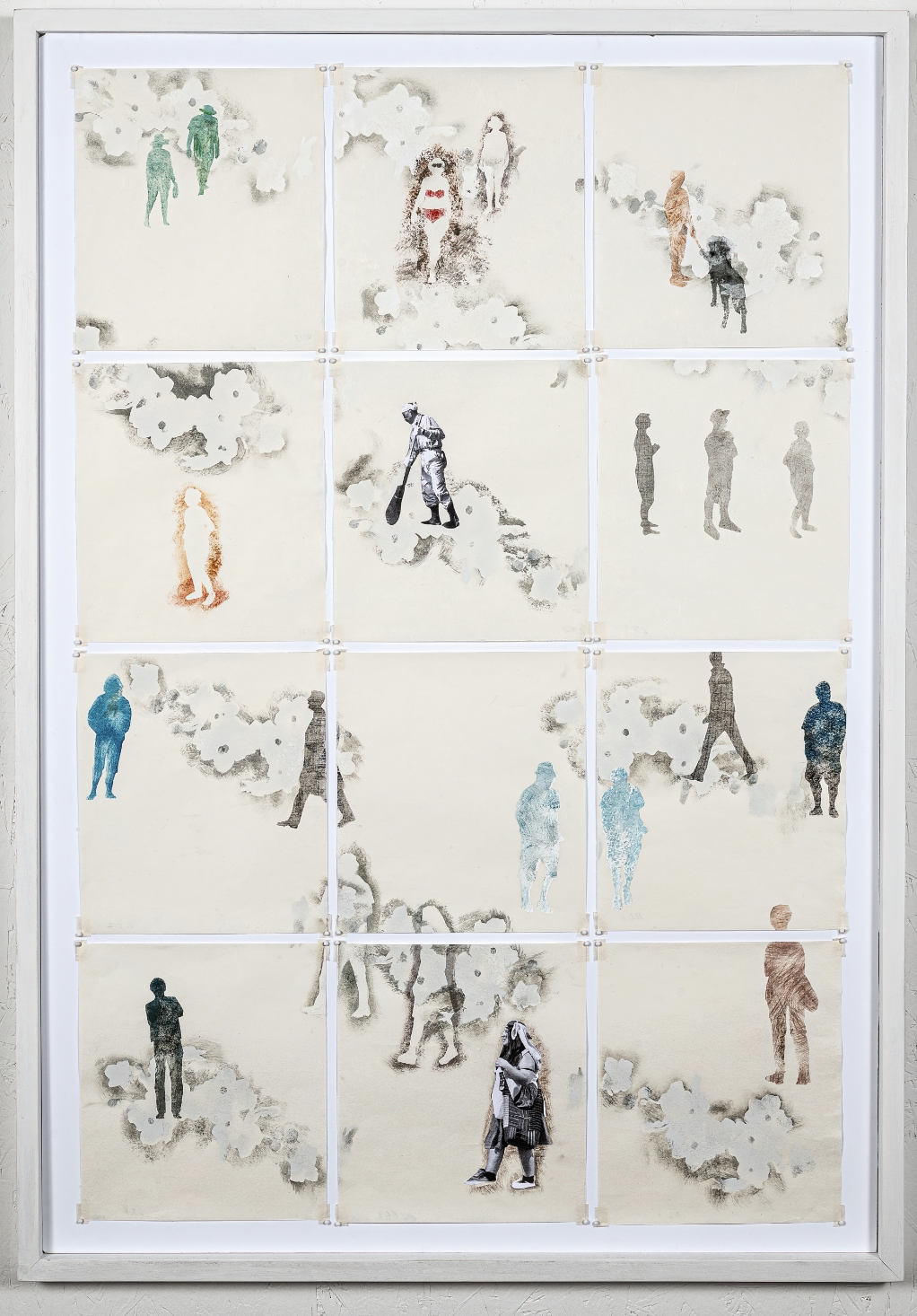
I love all the arts, and have always read voraciously now more in the form of audiobooks; enjoy all kinds of plays, poetry and dance. In the past few years I’ve been particularly drawn to looking at architecture and public-spirited design. Once married to an ecologist, his influence early on made me sensitive to ways that the earth can benefit from reduction of fossil fuels and I refused to own a car for decades. Perhaps I’ll find a way to express these concerns in my work but meanwhile I no longer use or breath petroleum based inks.
I keep an open mind filled with wonder, interested in learning new things when any doubts or puzzlements arise. Human behaviour is of particular interest especially when we were all challenged to adapt during the pandemic. As a result, figurative subject matter has entered my work. I’m interested in the subtle movements or expressions that characterise human responses to things. I’ve returned to attending life drawing sessions regularly.
It took a number years following graduation from OCA to understand what it meant to be an artist. I felt I had to make choices that furthered my ability to make art. This led me to Japan; leaving family, friends and job prospects, to depend on part time teaching there. At first I intended to study mokuhanga for a year, but meeting my future husband there, many more years were spent afterwards immersing myself in Japanese culture. Although married twice, I didn’t have children. It was a choice I made; but not necessarily something I’d recommend now with hindsight.
The mental training of printmaking encourages thinking ahead, planning carefully to achieve desired results. This has quite literally affected my personality and M.O. in all aspects of life. For instance after 11 years in Japan I had very few artistic connections back home except for one significant association – the printmaking facility, Open Studio in Toronto. I had brought my work back there for a solo exhibition in 1997 and reconnected then. After my return to Toronto, this affiliation was an important anchor for me to begin exhibiting again and having a like-minded community.
Are there any specific themes or messages that you aim to convey through your artwork?
The short answer is “no”, probably because over a long career interests change.
Here are few highlights of themes I’ve addressed:
Earlier in my career, before going to Japan, I created an installation of prints with a 3-D presentation of the woodcut matrices which explored the relationship between the creative act and major developments in the history of man. It was called Matrix of Invention (1987) and can be viewed on my website.
In Japan, I became interested in “straw culture” – the use of rice straw obtained after rice harvest to create both useful and symbolic objects (1995). My focus was expressing these objects in a series of black and white woodblock prints which were accompanied by painted wood hands suspended over them- suggesting my engagement in learning about the culture. Woodblock turned out to be most appropriate for carving the blades of rice straw.
After my return to Toronto, when in residence at the Gibraltar Point Centre for the Arts I became fascinated with Lake Ontario’s many moods all perceived against the same stable level of the horizon. This became a series of mokuhanga prints called “Margin” evoking Tennyson’s poem “Ulysses” as part of an exhibition at Open Studio.
Gathering Cirrus (from Margin), Elizabeth Forrest, landscape, lake Ontario, colour woodcut print, mokuhanga (aka Japanese woodblock prints), 22.2″ x 15.3″ (right).
The series was a contemplation too, of “the end” which we all begin to face as we get older. Like the other work while landscape in subject matter, it was also about the perception of that landscape.
Over the past 4 years, work which explored the ubiquitous screen through which we experience the world was my main theme. The umbrella title “Separations” for my most recent solo show not only dwelt on the screen as a separator from reality, but I also looked at the impact of “distancing” in a number of figuratively themed prints.
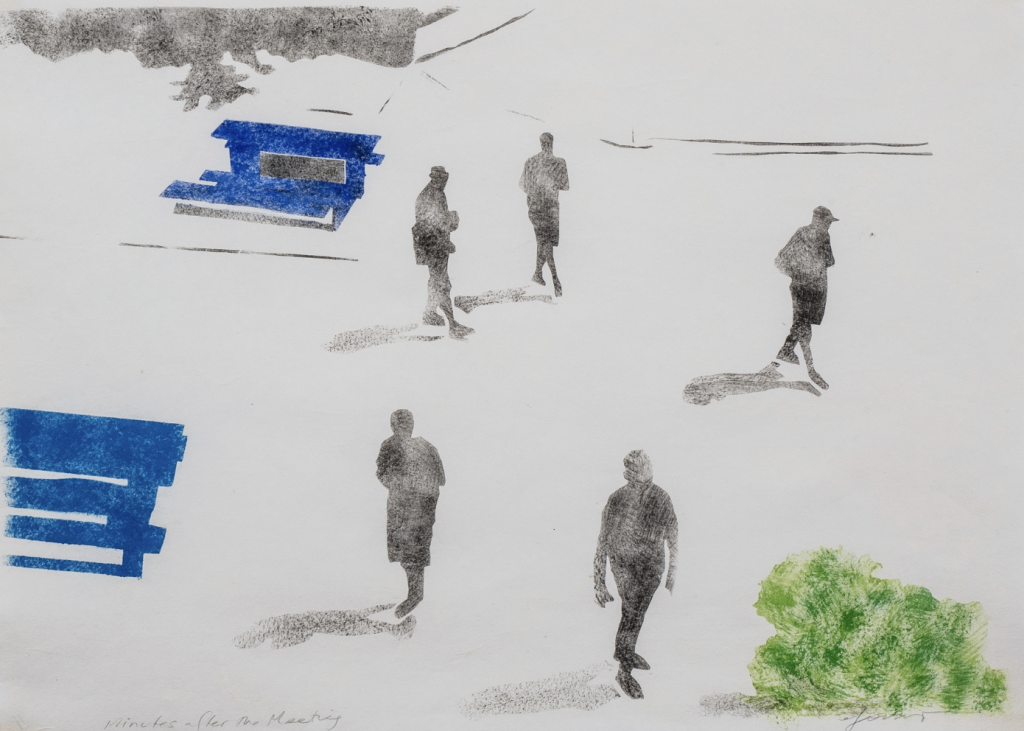
I think human behaviour almost always inhabits my work, even when no figure is present. The image becomes almost symbolic of some aspect of human psychology, perception or emotion. I can give examples of this from a variety of different works over the last 30 years.
What is the most rewarding aspect of being an artist?

I think now the most rewarding aspect is to be able to go to my studio and concentrate on making a piece of work without interruption.
How do you approach the creative process, and where do you find inspiration?
Mokuhanga at first entranced me with the essential beauty of the stain-like pigment absorbed into washi paper. This led to simplified images (The Grids, Margin series) that accommodated larger flat areas of colour and bokashi (colour blending). Some of the tropes I’ve used like blind embossing and blends were inspired by traditional Japanese ukiyoe prints. So certainly Japan has had a huge impact on how I work if not the subject matter or design per se.
Later, when intrigued by Newfoundland’s geographic characteristics during visits there, I found I had the skills I needed to pursue more complex imagery from that rich source.In one work, I was able to create the colour variations to depict stones I had collected there. Certain historical nuances entered my work during this period – themes such as abandonment and neglect, the constantly impinging wilderness and the tales that ancient rocks tell.
The recent “screen” series began when taking pictures through the screen on a veranda and adjusting the focus to sharpen the screen over a blurred background. I had been long fascinated with Utamaro (19th c Japanese woodblock artist) who used images of fine netting in a few of his prints. It was obvious to me that horizontal and vertical lines were overprinted to achieve the net effect. I also recognized how the foreground screen flattened the three dimensionality behind it so I experimented with making woodblock screens using laser cutting for a number of works completed during the pandemic, where we were isolated from the three dimensional world by our ubiquitous screens.
Can you share a memorable moment or achievement in your artistic journey that stands out to you?
Fortunately there are several of them, and the one I’ll describe is fairly recent. Last May 2022 while preparing for a solo show in Toronto I saw a public art Call for Entry – deadline about a week off. Part 1 was to design three perforated and painted, oval shade structures for a park in Waterloo. Part 2 was to design a second shade structure – a roof extension which was over a concrete seated area. In front of the seated area an 8- panel barrier was also to be placed. Despite the fact that I was so busy, I decided to chance an entry because I saw that the negative/positive of the perforation process was very much related woodblock print. So I was able to easily describe in my proposal why this proposed perforated structure was related to my medium. The ideas just came – my presentation began with pencil sketches and eventually were translated into computer drawings using only my track pad. I am still relatively new in Waterloo so with pleasure I researched the historically rich, academic neighbourhood around the parks’ location as well as nearby nature trails and found lots of ideas to incorporate into semi-abstract designs for the perforations. And to my amazed delight I won the competition. I’m still waiting for the parks to be completed along with my shade structures and barriers.
Have there been any challenges you’ve faced as an artist, and how did you overcome them?
I think I’ve been lucky and the current changes in the cultural climate highlight my good fortune as being a Canadian born, middle class white woman. Nevertheless I have been aware of bias against women in the art world – but it’s very subtle and often comes from unexpected directions. I feel my worst enemy in some instances was myself when in the past I lacked courage and self esteem to promote my work although I’m improving. I believe I’m resilient and not easily discouraged – failure is the great teacher. I think I got that from my parents who had lived through the Great Depression.
What advice do you have for aspiring artists looking to pursue a career in the art world?
That’s a hard one because so much has changed in recent years. It’s harder to stay afloat while going to expensive art school, harder to find a place to live, and I think colleges and universities now need to justify their existence by creating curricula that require the creative output of students to be justifiable. Hence the long artist statements and complex inquiry based work have become so predominant in art galleries. They could focus a bit more on skills for making a living in my honest opinion.
To young artists, all I can say is don’t give up. Find yourself not only in your work but in the world. You have to survive and you can’t just depend on others because there is usually a trade-off. Fine if you can deal with the trade-off – but it requires nerves of steel. For me a fair bit of solitude along with a few good friends, works well.
Do you want to be featured? Join Partial as a Pro artist and e-mail us at hello@partial.gallery. We’d love to share your work.

